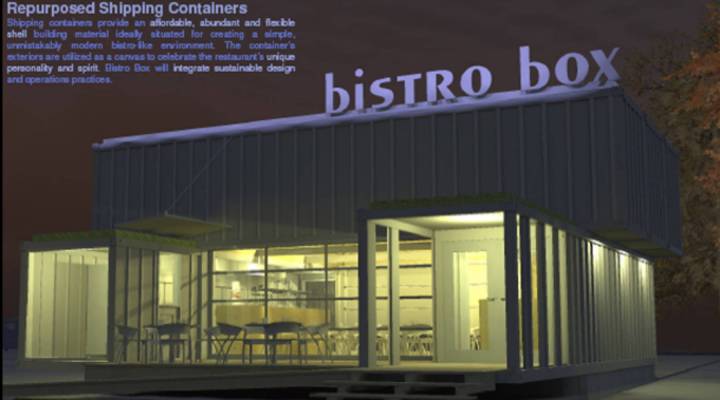
Sunflowers, pocket parks and other ideas aim to beautify vacant lots
Sunflowers, pocket parks and other ideas aim to beautify vacant lots

If you live in any large ‘rustbelt’ city in the Midwest, and St. Louis in particular, you’re probably all too familiar with the site of vacant lots. Empty land where homes and businesses used to be present a tough challenge for cities.
This weekend, ground will be broken on several projects which aim to change the way neighborhoods and cities deal with vacant property.
The Washington University Sustainable Land Lab Competition chose five winning designs from 48 design submissions. Phil Valko is the lab’s director. When you walk into his office, the first thing you see is a giant property map tacked to his wall.
“So, we’re looking at a map of the city of St. Louis,” says Valko gesturing to the wall. “This map is showing vacant land in the city, so much so that it almost seems that the dominant land use in the northern part of the city is vacancy.”
St. Louis spends upwards of $200,000 per year just to mow the grass on the 10,000 properties owned by the city’s Land Re-utilization authority (LRA). Another 10,000 vacant parcels are still in private ownership. The idea behind the land lab is to rethink the possibilities for this land, in lieu of new buildings.
“Are there innovations, are their ideas, using a modest amount of money, that could have a different, or better outcome than simply cutting grass?” asks Valko.
Getting past the sadness of empty lots
When trying to wrap your head around a city like St. Louis, or Detroit, or Youngstown, Ohio, most people are touched by a kind of melancholy, a sense of loss for once-great metropolis that has fallen on hard times.
Sean Thomas, of St. Louis’ Old North Restoration Group, says people need to get past that sadness, because these cities will never look like they did before…and that’s okay: “I would say 30 years ago people would say this neighborhood [Old North] didn’t have a future at all. 20 years ago people probably would have said that and maybe even some 10 years ago.”
In recent years however Old North has become kind of famous in urban planning circles as a testing ground for new ideas in urban redevelopment.
One of those ideas is this empty lot between two brick storefronts.
“There will be tables with chessboards engraved onto them, and we’ll have chess pieces in our office across the street here for people to check out,” says Thomas. “The hope is this will become a gathering place for people who care about chess and want to learn how to play chess.”
The “chess pocket park,” will become the first outdoor chess park in the city, and will even feature monthly lessons from a chess grand master.
Better options for cities
Through the competition, the hope is that the Land Lab with create a toolkit of basic projects that could be easily replicated, and at minimal cost, throughout the city.
Other winning designs also include a restaurant made out of empty shipping containers, a giant solar calendar, even a field of sunflowers. Each team will receive seed money totaling $5,000 in addition to whatever money they can raise on their own.
Several blocks away, an empty lot will soon be planted in with sunflowers in the spring and summer, and then winter wheat in the fall.
“Imagining this place that we’re standing in six-foot tall sunflowers is a nice thought for me right now,” says Don Koster, one of co-designers of the Sunflower+ Project.
In addition to being pretty to look at, sunflowers have are also good at filtering contaminated soils, particularly lead. It’s a classic low lost, no risk, high upside scenario.
And the worst thing that could happen would be that this lot eventually just goes back to being a vacant lot.
“Well…hopefully it goes back to being a vacant lot with better soil quality,” corrects Koster.
And while some of these ideas may seem…what’s the word? Pollyannaish? Cities need new options for vacant land. And it’s hard to tell what works until you try it.
“You’re not going to put a wind farm in every neighborhood, or whatever it might be,” says City of St. Louis Sustainability Director Catherine Werner.
Werner says she hopes the four projects create enough interest and enthusiasm that the city can quickly replicate and expand the experiment to other parts of St. Louis.
“You know, we have 20,000 or so vacant properties, 10,000 of which are owned by the city, 8000 of those are vacant land. I don’t think we have any choice but to think that’s what our future will be.”
Werner says projects like the Land Lab are a perfect way to see what works, what doesn’t, and then share that information with other cities.
If her St. Louis can do that, she says, maybe it can reframe the rustbelt narrative, away from what happened in the past and start focusing on the future.
There’s a lot happening in the world. Through it all, Marketplace is here for you.
You rely on Marketplace to break down the world’s events and tell you how it affects you in a fact-based, approachable way. We rely on your financial support to keep making that possible.
Your donation today powers the independent journalism that you rely on. For just $5/month, you can help sustain Marketplace so we can keep reporting on the things that matter to you.


















